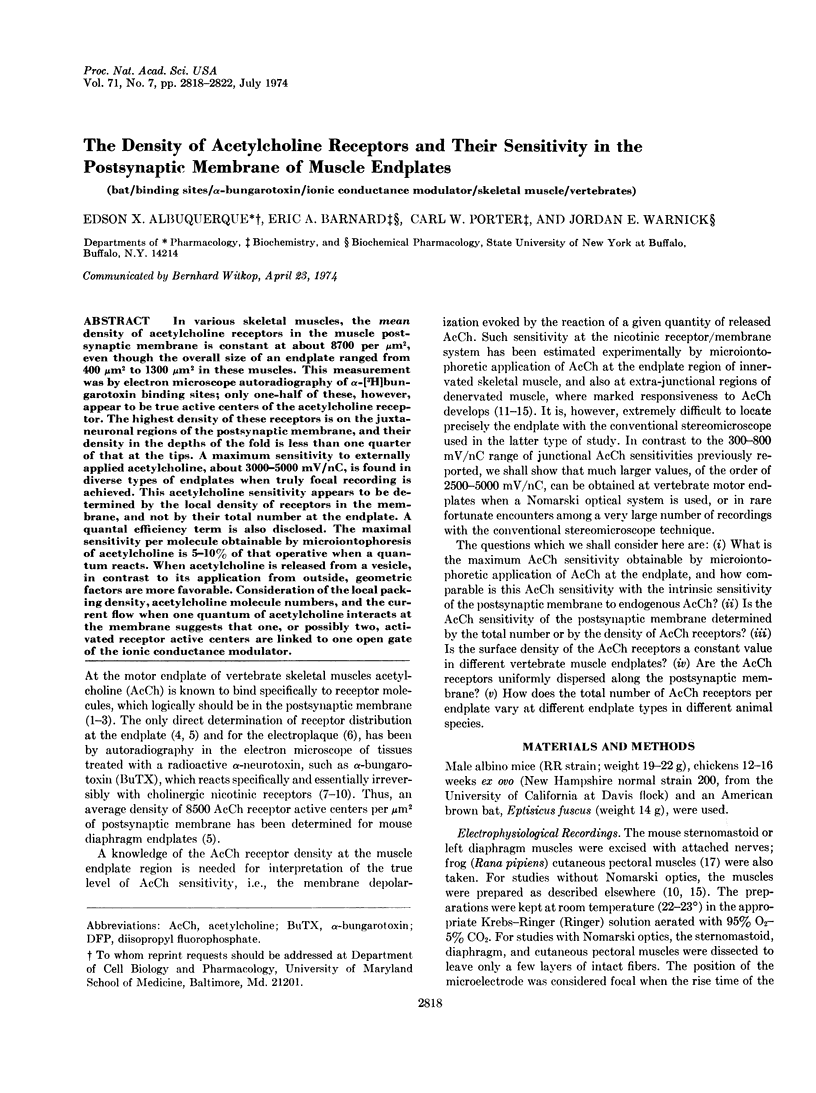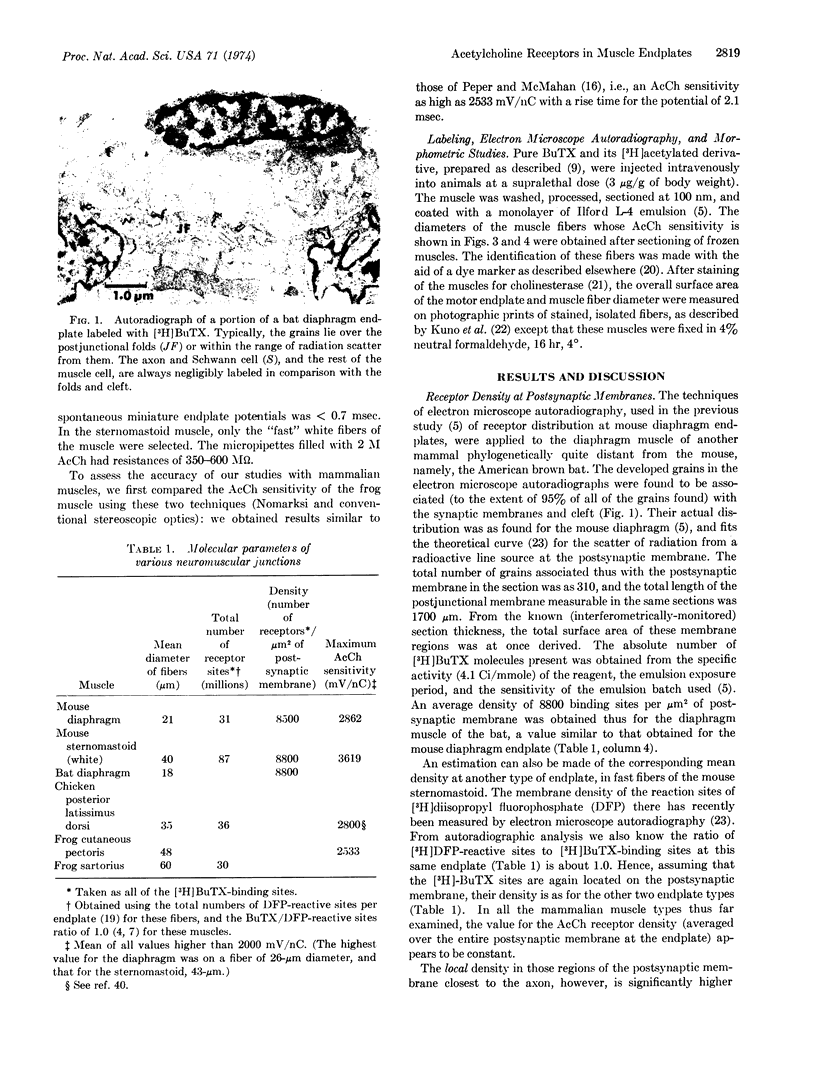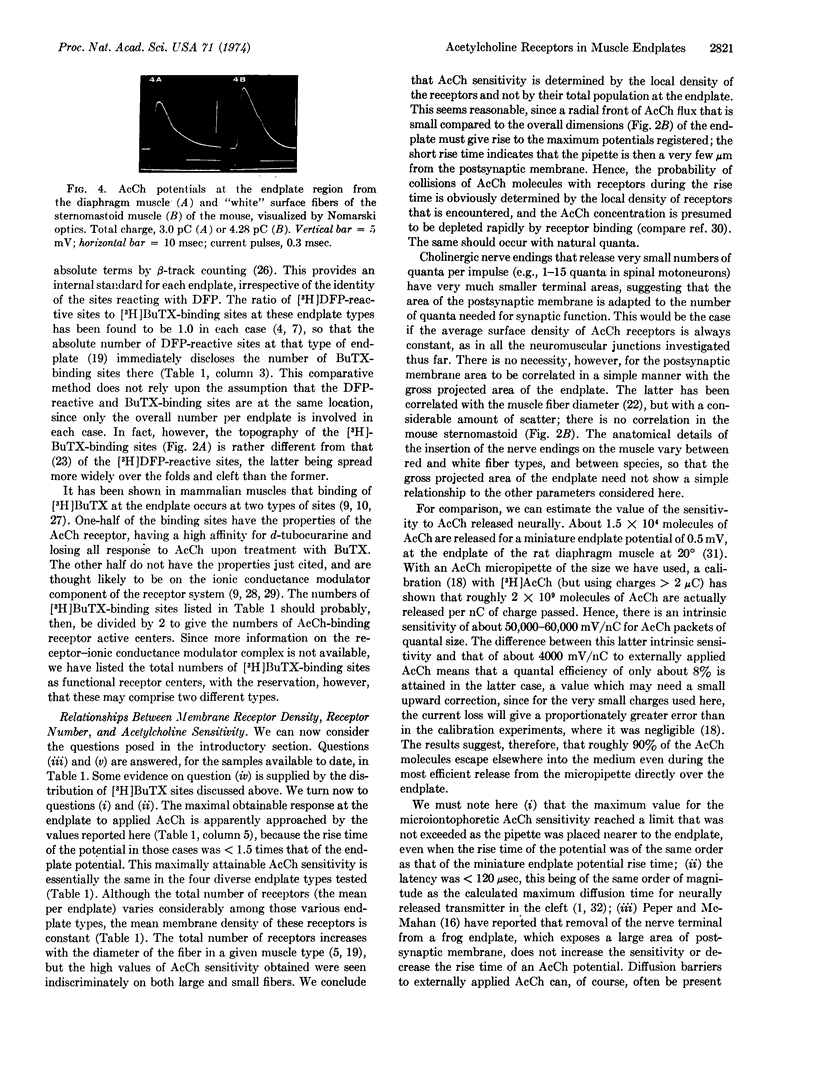Abstract
In various skeletal muscles, the mean density of acetylcholine receptors in the muscle postsynaptic membrane is constant at about 8700 per μm2, even though the overall size of an endplate ranged from 400 μm2 to 1300 μm2 in these muscles. This measurement was by electron microscope autoradiography of α-[3H]bungarotoxin binding sites; only one-half of these, however, appear to be true active centers of the acetylcholine receptor. The highest density of these receptors is on the juxtaneuronal regions of the postsynaptic membrane, and their density in the depths of the fold is less than one quarter of that at the tips. A maximum sensitivity to externally applied acetylcholine, about 3000-5000 mV/nC, is found in diverse types of endplates when truly focal recording is achieved. This acetylcholine sensitivity appears to be determined by the local density of receptors in the membrane, and not by their total number at the endplate. A quantal efficiency term is also disclosed. The maximal sensitivity per molecule obtainable by microiontophoresis of acetylcholine is 5-10% of that operative when a quantum reacts. When acetylcholine is released from a vesicle, in contrast to its application from outside, geometric factors are more favorable. Consideration of the local packing density, acetylcholine molecule numbers, and the current flow when one quantum of acetylcholine interacts at the membrane suggests that one, or possibly two, activated receptor active centers are linked to one open gate of the ionic conductance modulator.
Keywords: bat, binding sites, α-bungarotoxin, ionic conductance modulator, skeletal muscle, vertebrates
Full text
PDF




Images in this article
Selected References
These references are in PubMed. This may not be the complete list of references from this article.
- AXELSSON J., THESLEFF S. A study of supersensitivity in denervated mammalian skeletal muscle. J Physiol. 1959 Jun 23;147(1):178–193. doi: 10.1113/jphysiol.1959.sp006233. [DOI] [PMC free article] [PubMed] [Google Scholar]
- Albuquerque E. X., Barnard E. A., Chiu T. H., Lapa A. J., Dolly J. O., Jansson S. E., Daly J., Witkop B. Acetylcholine receptor and ion conductance modulator sites at the murine neuromuscular junction: evidence from specific toxin reactions. Proc Natl Acad Sci U S A. 1973 Mar;70(3):949–953. doi: 10.1073/pnas.70.3.949. [DOI] [PMC free article] [PubMed] [Google Scholar]
- Albuquerque E. X., Barnard E. A., Jansson S. E., Wieckowski J. Occupancy of the cholinergic receptors in relation to changes in the endplate potential. Life Sci. 1973 Jun 15;12(12):545–552. doi: 10.1016/0024-3205(73)90058-1. [DOI] [PubMed] [Google Scholar]
- Albuquerque E. X., McIsaac R. J. Fast and slow mammalian muscles after denervation. Exp Neurol. 1970 Jan;26(1):183–202. doi: 10.1016/0014-4886(70)90099-3. [DOI] [PubMed] [Google Scholar]
- Anderson C. R., Stevens C. F. Voltage clamp analysis of acetylcholine produced end-plate current fluctuations at frog neuromuscular junction. J Physiol. 1973 Dec;235(3):655–691. doi: 10.1113/jphysiol.1973.sp010410. [DOI] [PMC free article] [PubMed] [Google Scholar]
- Barnard E. A., Wieckowski J., Chiu T. H. Cholinergic receptor molecules and cholinesterase molecules at mouse skeletal muscle junctions. Nature. 1971 Nov 26;234(5326):207–209. doi: 10.1038/234207a0. [DOI] [PubMed] [Google Scholar]
- Bourgeois J. -P., Ryter A., Menez A., Fromageot P., Boquet P., Changeux J. -P. Localization of the cholinergic receptor protein in Electrophorus electroplax by high resolution autoradiography. FEBS Lett. 1972 Sep 1;25(1):127–133. doi: 10.1016/0014-5793(72)80469-1. [DOI] [PubMed] [Google Scholar]
- Bradley P. B., Candy J. M. Iontophoretic release of acetylcholine, noradrenaline, 5-hydroxytryptamine and D-lysergic acid diethylamide from micropipettes. Br J Pharmacol. 1970 Oct;40(2):194–201. doi: 10.1111/j.1476-5381.1970.tb09913.x. [DOI] [PMC free article] [PubMed] [Google Scholar]
- Braun M., Schmidt R. F. Potential changes recorded from the frog motor nerve terminal during its activation. Pflugers Arch Gesamte Physiol Menschen Tiere. 1966;287(1):56–80. doi: 10.1007/BF00362454. [DOI] [PubMed] [Google Scholar]
- Chiu T. H., Lapa A. J., Barnard E. A., Albuquerque E. X. Binding of D-tubocurarine and alpha-bungarotoxin in normal and denervated mouse muscles. Exp Neurol. 1974 May;43(2):399–413. doi: 10.1016/0014-4886(74)90180-0. [DOI] [PubMed] [Google Scholar]
- ECCLES J. C., JAEGER J. C. The relationship between the mode of operation and the dimensions of the junctional regions at synapses and motor end-organs. Proc R Soc Lond B Biol Sci. 1958 Jan 1;148(930):38–56. doi: 10.1098/rspb.1958.0003. [DOI] [PubMed] [Google Scholar]
- Feltz A., Mallart A. An analysis of acetylcholine responses of junctional and extrajunctional receptors of frog muscle fibres. J Physiol. 1971 Oct;218(1):85–100. doi: 10.1113/jphysiol.1971.sp009605. [DOI] [PMC free article] [PubMed] [Google Scholar]
- Gage P. W., Armstrong C. M. Miniature end-plate currents in voltage-clamped muscle fibre. Nature. 1968 Apr 27;218(5139):363–365. doi: 10.1038/218363b0. [DOI] [PubMed] [Google Scholar]
- Heuser J. E., Reese T. S., Landis D. M. Functional changes in frog neuromuscular junctions studied with freeze-fracture. J Neurocytol. 1974 Mar;3(1):109–131. doi: 10.1007/BF01111936. [DOI] [PubMed] [Google Scholar]
- Hubbard J. I. Microphysiology of vertebrate neuromuscular transmission. Physiol Rev. 1973 Jul;53(3):674–723. doi: 10.1152/physrev.1973.53.3.674. [DOI] [PubMed] [Google Scholar]
- Hubbard J. I., Wilson D. F. Neuromuscular transmission in a mammalian preparation in the absence of blocking drugs and the effect of D-tubocurarine. J Physiol. 1973 Jan;228(2):307–325. doi: 10.1113/jphysiol.1973.sp010088. [DOI] [PMC free article] [PubMed] [Google Scholar]
- KATZ B., MILEDI R. THE MEASUREMENT OF SYNAPTIC DELAY, AND THE TIME COURSE OF ACETYLCHOLINE RELEASE AT THE NEUROMUSCULAR JUNCTION. Proc R Soc Lond B Biol Sci. 1965 Feb 16;161:483–495. doi: 10.1098/rspb.1965.0016. [DOI] [PubMed] [Google Scholar]
- KRNJEVIC K., MILEDI R. Acetylcholine in mammalian neuromuscular transmission. Nature. 1958 Sep 20;182(4638):805–806. doi: 10.1038/182805b0. [DOI] [PubMed] [Google Scholar]
- Katz B., Miledi R. The binding of acetylcholine to receptors and its removal from the synaptic cleft. J Physiol. 1973 Jun;231(3):549–574. doi: 10.1113/jphysiol.1973.sp010248. [DOI] [PMC free article] [PubMed] [Google Scholar]
- Katz B., Miledi R. The statistical nature of the acetycholine potential and its molecular components. J Physiol. 1972 Aug;224(3):665–699. doi: 10.1113/jphysiol.1972.sp009918. [DOI] [PMC free article] [PubMed] [Google Scholar]
- Kuba K., Albuquerque E. X., Daly J., Barnard E. A. A study of the irreversible cholinesterase inhibitor, diisopropylfluorophosphate, on time course of end-plate currents in frog sartorius muscle. J Pharmacol Exp Ther. 1974 May;189(2):499–512. [PubMed] [Google Scholar]
- Kuno M., Turkanis S. A., Weakly J. N. Correlation between nerve terminal size and transmitter release at the neuromuscular junction of the frog. J Physiol. 1971 Mar;213(3):545–556. doi: 10.1113/jphysiol.1971.sp009399. [DOI] [PMC free article] [PubMed] [Google Scholar]
- Lapa A. J., Albuquerque E. X., Daly J. An electrophysiological study of the effects of D-tubocurarine, atropine, and alpha-bungarotoxin on the cholinergic receptor in innervated and chronically denervated mammalian skeletal muscles. Exp Neurol. 1974 May;43(2):375–398. doi: 10.1016/0014-4886(74)90179-4. [DOI] [PubMed] [Google Scholar]
- Lebeda F. J., Warnick J. E., Albuquerque E. X. Electrical and chemosensitive properties of normal and dystrophic chicken muscles. Exp Neurol. 1974 Apr;43(1):21–37. doi: 10.1016/0014-4886(74)90131-9. [DOI] [PubMed] [Google Scholar]
- Lee C. Y. Chemistry and pharmacology of polypeptide toxins in snake venoms. Annu Rev Pharmacol. 1972;12:265–286. doi: 10.1146/annurev.pa.12.040172.001405. [DOI] [PubMed] [Google Scholar]
- McArdle J. J., Albuquerque E. X. A study of the reinnervation of fast and slow mammalian muscles. J Gen Physiol. 1973 Jan;61(1):1–23. doi: 10.1085/jgp.61.1.1. [DOI] [PMC free article] [PubMed] [Google Scholar]
- Negrette J., Del Castillo J., Escobar I., Yankelevich G. Spreading activation of end-plate receptors by single transmitter quanta. Nat New Biol. 1972 Feb 2;235(57):158–159. doi: 10.1038/newbio235158a0. [DOI] [PubMed] [Google Scholar]
- Porter C. W., Barnard E. A., Chiu T. H. The ultrastructural localization and quantitation of cholinergic receptors at the mouse motor endplate. J Membr Biol. 1973;14(4):383–402. doi: 10.1007/BF01868086. [DOI] [PubMed] [Google Scholar]
- Rogers A. W., Darzynkiewicz Z., Salpeter M. M., Ostrowski K., Barnard E. A. Quantitative studies on enzymes in structures in striated muscles by labeled inhibitor methods. I. The number of acetylcholinesterase molecules and of other DFP-reactive sites at motor endplates, measured by radioautography. J Cell Biol. 1969 Jun;41(3):665–685. doi: 10.1083/jcb.41.3.665. [DOI] [PMC free article] [PubMed] [Google Scholar]
- Salpeter M. M., Plattner H., Rogers A. W. Quantitative assay of esterases in end plates of mouse diaphragm by electron microscope autoradiography. J Histochem Cytochem. 1972 Dec;20(12):1059–1068. doi: 10.1177/20.12.1059. [DOI] [PubMed] [Google Scholar]
- TAKEUCHI A., TAKEUCHI N. Further analysis of relationship between end-plate potential and end-plate current. J Neurophysiol. 1960 Jul;23:397–402. doi: 10.1152/jn.1960.23.4.397. [DOI] [PubMed] [Google Scholar]
- Wilson V. J., Kato M., Thomas R. C., Peterson B. W. Excitation of lateral vestibular neurons by peripheral afferent fibers. J Neurophysiol. 1966 May;29(3):508–529. doi: 10.1152/jn.1966.29.3.508. [DOI] [PubMed] [Google Scholar]





